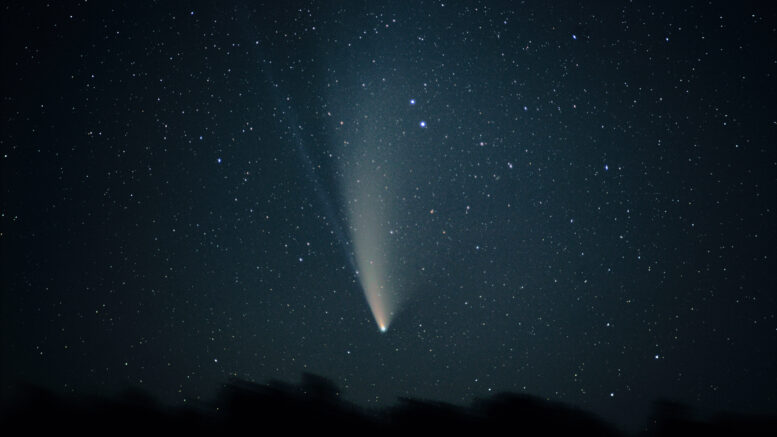First discovered in January 2023, and then on independently again on February 22, 2023 by another system, Comet C/2023-A3 Tsuchinshan-ATLAS gets its name because of the discoverers. The January 2023 sighting was made by the Tsuchinshan Chinese Observatory (Purple Mountain Observatory of the Chinese Academy of Sciences) and the February 2023 sighting was made by Asteroid Terrestrial-impact Last Alert System (ATLAS). The comet has a retrograde orbit, which means that it moves in the opposite direction to the majority of the major solar system objects. The orbit is parabolic-like with a perihelion distance of 0.39 astronomical units.
What makes the comet notable and actively observed, plus tracked is a result of the current predictions of it becoming bright enough to be visible to the naked eye during its perihelion passage between September and October 2024.
This brings up the questions of: How bright the object will be in the night sky? Where in the night sky will it be seen? When can one see it at night? How will it move in the sky? Lets take some time to answer these questions!
In late August and most of September, you won’t be able to see Comet C/2023 A3 (Tsuchinshan-ATLAS) because it will be too close to the Sun in the sky. The comet will pass the perihelion at a distance of 0.39 AU on September 27, 2024, and will be closest to Earth on October 12, with a predicted brightness of magnitude 0.
However, at the end of September, the comet will move far enough from the Sun to become visible, and at said time, magnitude will continue to increase. If this is the case, it would mean that the comet would possibly be the brightest comet seen in the northern hemisphere in nearly 27 years after Comet Hale-Bopp.
For those in the Northern Hemisphere, here is a great breakdown from starwalk.space:
- From September 27 to October 2, it appears very low above the horizon in the morning in the Northern Hemisphere, then disappears for several days until about October 11.
- October: the best month for observations in the Northern Hemisphere. Around its closest approach to Earth on October 12, the comet will be at its brightest (magnitude might be up to -3). It will be located relatively high above the horizon in the evening sky.
- November: from 4.5 to 8 magnitude, visible in the evening. Rises higher in the Northern Hemisphere after sunset.
- December: from 8 to 10 magnitude. Gradually moves closer to the Sun in our sky, rising lower above the horizon. Not visible from the Southern Hemisphere.
Viewing Recommendations: Go somewhere you can view the entire Western Sky, like Stub Stewart State Park!
The first image below is from stellarium, and shows the location of the comet on October 12th, which is the expected peak brightness. As shown below, the comet is hovering a bit more to the west (almost Due West) compared to Venus and is almost as close to the horizon. As the night progresses, the comet will dip below the horizon.

For those looking for a time at which the comet to be higher in the sky because there isnt an opportunity to get to skies with such a clear view of the Western horizon, the comet will be at its highest around November 2nd, 2024 as shown in image 2 below.

Stay tuned to see what happens with Comet C/2023-A3 Tsuchinshan-ATLAS! Does it breakup before becoming fully visible? Follow us on Twitter and Instagram, and make sure to check out other articles this for more amazing content like this.

Be the first to comment on "How To View Comet C/2023-A3 Tsuchinshan-ATLAS"